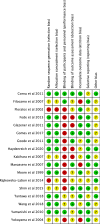A systematic review of treatment options for post-prostatectomy incontinence
- PMID: 36107210
- PMCID: PMC9617828
- DOI: 10.1007/s00345-022-04146-5
A systematic review of treatment options for post-prostatectomy incontinence
Abstract
Purpose: Urinary incontinence remains common in men after prostatectomy. Current guidance suggests early corrective surgery to those that are still incontinent after trying Pelvic Floor Muscle Therapy, however, other treatments are now available. This review aims to evaluate all currently available treatment options for men with post-prostatectomy incontinence (PPI).
Methods: A search of MEDLINE and CENTRAL databases on 2/2/2021 produced 879 articles. Any study evaluating incontinence before and after a treatment protocol was eligible for inclusion. After screening, 17 randomized control trials were included, and pre-defined data points were collected. Due to heterogeneity, pooled analysis was not possible, and a descriptive synthesis was produced in accordance with PRISMA guidelines. Cochrane Risk of Bias (RoB) tool was used to evaluate all studies. The search protocol and methods for this study was registered on the PROSPERO database before the search began, ID:(CRD42021229749).
Results: 3/17(18%) of studies focussed on pharmacotherapy, 2/17(12%) on vibration therapies, 8/17(47%) on pelvic floor muscle therapy (PFMT), 3/17(18%) on electrical stimulation (ES), and 1/17 (6%) on extracorporeal magnetic innervation (ExMI) as their main intervention. The use of Duloxetine, Solifenacin, PFMT, ES, and ExMI all show effective reduction in incontinence in men suffering from PPI. No study in this review evaluated surgical managements for PPI.
Conclusion: A large number of treatments are available for PPI using an array of different methods. For this reason, a variety of treatments could be considered before early invasive procedures, to prevent unnecessary surgery and its associated negative complications.
Keywords: Incontinence; PPI; Post-prostatectomy; Prostate; Prostatectomy; Urology.
© 2022. The Author(s).
Figures
References
-
- Nahon I, Dorey G, Waddington G, Adams R. Systematic review of the treatment of post-prostatectomy incontinence. Urol Nurs. 2006;26(6):461–475. - PubMed
Publication types
MeSH terms
LinkOut - more resources
Full Text Sources
Medical



